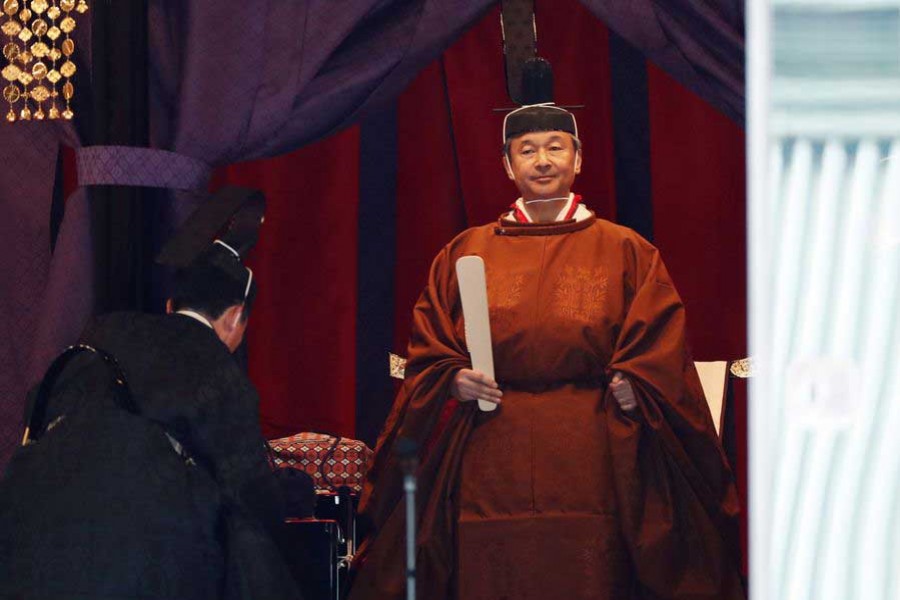Japanese Emperor Naruhito on Tuesday proclaimed his enthronement in a highly ritualised, ancient-style ceremony held in the Seiden State Hall at the Imperial Palace in Tokyo in front of 2,000 guests from around the world.
In the official coronation ceremony known as "Sokuirei Seiden no gi," the 59-year-old emperor wearing a dark reddish-brown robe known as a "Korozen no goho" only worn by emperors, made his ascension to the 6.5-metre-high canopied Takamikura imperial throne.
Flanked by the imperial sword and jewel, two of the three items of imperial regalia inherited by the emperor as proof of his ascension, along with the state and privy seals, Emperor Naruhito proceeded to proclaim his enthronement. Empress Masako was seated on the adjacent Michodai throne wearing a layered court kimono, known as a traditional Japanese garment.
"In accordance with the Constitution of Japan and the Special Measures Law on the Imperial House Law, I now perform the Ceremony of Enthronement at the Seiden State Hall and proclaim my enthronement to those at home and abroad," he said.
"For more than 30 years on the Throne, His Majesty the Emperor Emeritus (Akihito) constantly prayed for the happiness of the people and world peace, always sharing in the joys and sorrows of the people, and showing compassion through his own bearing."
"I pledge hereby that I shall act according to the Constitution and fulfill my responsibility as the symbol of the State and of the unity of the people of Japan, while always wishing for the happiness of the people and the peace of the world, turning my thoughts to the people and standing by them," Emperor Naruhito continued.
In his final words, the emperor wished for the peace and prosperity of mankind.
"I sincerely hope that our country, through our people's wisdom and unceasing efforts, achieves further development and contributes to the friendship and peace of the international community and the welfare and prosperity of mankind."
Following the emperor's proclamation, Japanese Prime Minister Shinzo Abe, wearing a black tail coat and white bow tie, paid his formal congratulatory tribute to the emperor from the lower floor of the "Matsu-no-Ma" state room.
"The people of Japan come together in extending their heartiest congratulations," said the Japanese leader after confirming the emperor's ascension to the throne to both representatives at home and abroad.
He added that the emperor had said in his proclamation that he would reflect deeply on the course followed by his majesty the Emperor Emeritus in always wishing for the happiness of the people and world peace and had pledged to stand by the people and act in accordance with the Constitution in fulfilling his responsibility as a symbol of the state.
Abe said he was deeply touched by the emperor's words on contributing to the friendship and peace of the international community, as well as to the welfare and prosperity of mankind.
"We take pride in a Japan that is peaceful and brimming with hope in an era of culture coming into being and flourishing when people bring their hearts and minds together in a beautiful manner," the prime minister said in his congratulatory speech.
"I hereby pray for peace in the era of Reiwa and extend my best wishes for the imperial household to flourish further," said the Japanese leader in his closing remarks to Emperor Naruhito.
The Japanese premier then led the attendees in three rounds of "banzai" cheers, which were followed by a 21-gun salute.
Prior to proclaiming his enthronement, the emperor, at 9:00 a.m. local time Tuesday, wearing a white robe, visited the three Imperial sanctuaries to report to various deities that the enthronement ceremony will be held today, in the first of the ceremonial rituals.
The empress, in a white-layered kimono visited the sanctuaries separately.
Emperor Naruhito's reign began on May 1 as he ascended the Chrysanthemum Throne, marking the beginning of a new imperial era in Japan.
His reign and the new Reiwa Era began following the abdication of his father, former Emperor Akihito.
Emperor Naruhito, following the abdication of his father, became Japan's 126th emperor according to the traditional order of succession and will continue in his father's footsteps as a "symbol of the state."
Emperor Emeritus Akihito in his final speech as a monarch before stepping down a day before Emperor Naruhito's reign began, officially declared his abdication and in doing so said he sincerely hoped for a stable future for Japan and peace and happiness around the world.
Emperor Emeritus Akihito's abdication marked the end of the three-decade long Heisei Era and the first time a live monarch here has left the Chrysanthemum Throne in more than 200 years.
He was Japan's 125th emperor according to the traditional order of succession and expressed his desire to step down and relinquish his position in a rare video message broadcast in 2016.
During the video message he expressed his concern that owing to his age he might not be able to fulfill his official duties.
A year later, parliament passed a one-off bill enabling him to do so and laying the groundwork for Emperor Naruhito's current reign.
Tuesday's enthronement proclamation ceremony, attended by dignitaries from around 190 countries and international organisations, will be followed by a banquet to be held in the evening.
The enthronement parade for Emperor Naruhito that was scheduled to take place following Tuesday's enthronement proclamation, however, has been postponed.
The much-anticipated parade that is expected to draw crowds of thousands will now be held on Nov. 10.
The rescheduling of the procession is so that the government can focus on dealing with the damage caused by Typhoon Hagibis.
The most powerful typhoon to hit Japan in decades ripped through the country from Oct. 12-13, wreaking extensive damage on wide swathes of the country and leaving at least 83 people dead and 4,000 still displaced in evacuation shelters.


